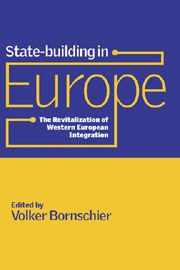Book contents
- Frontmatter
- Contents
- List of figures and tables
- List of contributors
- Preface
- Acknowledgements
- Part I State-building and Political Entrepreneurship
- Part II The Core Elements in Recasting the European Bargain
- 3 The origins of the Single Market
- 4 Esprit and technology corporatism
- 5 EC regional policy: monetary lubricant for economic integration?
- 6 EC social policy: the defeat of the Delorist project
- Part III Conclusions beyond the Single European Act of 1986
- Appendix List of interview partners
- Bibliography
- Index
5 - EC regional policy: monetary lubricant for economic integration?
Published online by Cambridge University Press: 10 October 2009
- Frontmatter
- Contents
- List of figures and tables
- List of contributors
- Preface
- Acknowledgements
- Part I State-building and Political Entrepreneurship
- Part II The Core Elements in Recasting the European Bargain
- 3 The origins of the Single Market
- 4 Esprit and technology corporatism
- 5 EC regional policy: monetary lubricant for economic integration?
- 6 EC social policy: the defeat of the Delorist project
- Part III Conclusions beyond the Single European Act of 1986
- Appendix List of interview partners
- Bibliography
- Index
Summary
The cohesion target – introductory remarks to chapters 5 and 6
Along with the internal market project and technology policy, regional and social policy elements are additional important political dimensions of the integration thrust of the 1980s. The consistency with which the cohesion target is reinforced in its various formulations in the conclusions of European summit meetings and annual Commission programmes is impressive. This no doubt reflects the societal consensus in all member states of the EC regarding the necessity and desirability, in accordance with Marshall's famous definition of social policy, ‘to use political power to supersede, supplement or modify operations of the economic system in order to achieve results which the economic system would not achieve on its own’ (Marshall 1975: 15). The principle of state-organized balancing between classes and regions was and is a central element of the Western postwar model (Bornschier 1996), even when there were and are different forms and levels of development among the member states (see Esping-Andersen 1990; Schmid 1995). This societal consensus continues to exist in Western Europe, as surveys show (Ferrera 1993), even during the present tumultuous times of fiscal crisis and system rebuilding.
In this context, the definition of the functions that the European Community, as one level of statehood in Europe, is supposed to take on remains controversial. In fact, in the 1980s the cohesion target was anchored in the treaties, which represented a marked expansion of the ‘welfare state mission’ of the Community. For the proponents of a European federal state, the existing EC functions in this domain are stages on the way to a supranational system of social policy regulation with financial equalization.
- Type
- Chapter
- Information
- State-building in EuropeThe Revitalization of Western European Integration, pp. 122 - 151Publisher: Cambridge University PressPrint publication year: 2000
- 2
- Cited by



